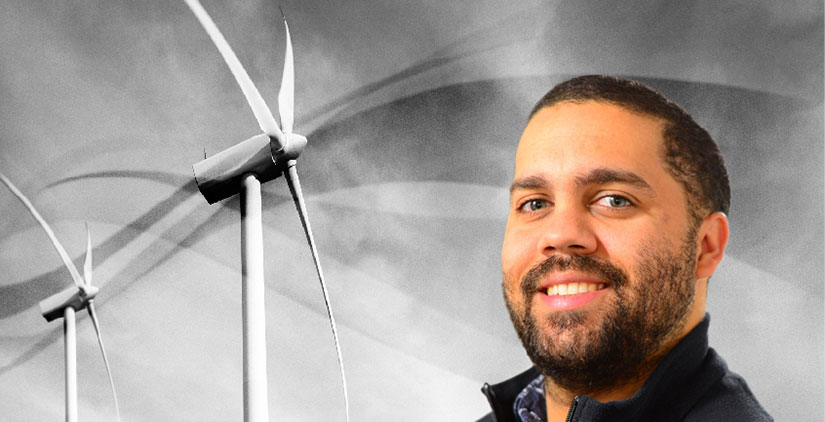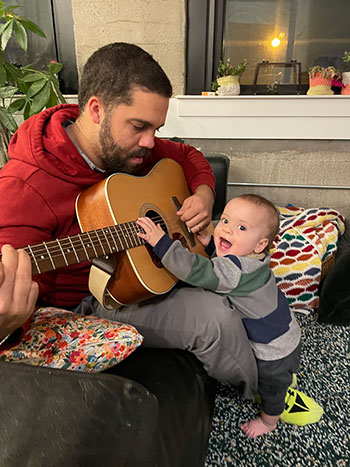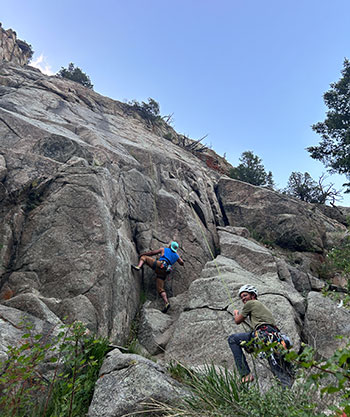Behind the Blades: Cory Frontin Finds His Rhythm in Renewable Energy
Aerodynamicist Streamlines Simulations While Finding Creative Freedom in Jazz Guitar

When Cory Frontin is not developing simulation methods for wind and renewable energy, he likes to do “typical outdoorsy Colorado things,” like rock climbing. He also likes to play jazz guitar.
The NREL mechanical engineering researcher was an accomplished saxophone player in high school. As an undergraduate student at the University of Maryland, he intended to double major in aerospace, aeronautical, and astronautical engineering and jazz studies. However, when he was a Ph.D. candidate at the Massachusetts Institute of Technology, he traded reeds and keys for pegs and strings.
“I lived in an apartment at the time, and you can't practice saxophone in an apartment without becoming a terrible neighbor,” Frontin explained. “With a guitar, you can plug in your headphones and practice without bothering anyone.”
Another factor in the switch? The freedom he found in learning something new.

“I stopped playing saxophone for a while after undergrad,” Frontin said. “During my Ph.D., which coincided with the pandemic, I got interested in playing music again. But I had gotten so rusty that it was kind of brutal to try to pick up the saxophone and feel like a total beginner again. When I switched to guitar, I didn’t feel like I should already be good at it, but at the same time, I didn’t have to relearn how to play music entirely. That allowed me to learn in a new and creative way.”
Frontin has learned similar lessons as he has applied his knowledge of aerodynamics to the challenges of wind and renewable energy production.
“I started at NREL in 2023 as a postdoctoral researcher, and renewable energy was a new field for me,” Frontin said. “But even though the application was new, the same general principles of aerodynamics applied. It wasn’t like I had to learn aerodynamics all over again. So that freed up time and brainpower to think about all the other pieces of the wind and renewable energy puzzle.”
Read on to learn more about Frontin’s work, his thoughts on the many pieces of the clean energy puzzle, and how he would like to add to a famous scientific saying.
Tell us about your work at NREL.
Generally, I build mathematical and computational frameworks that improve the efficiency of simulation. The goal is to help researchers run the simulation that yields the most information about the question I want to answer and to quickly extract the relevant information from the simulation. Then I incorporate that simulation data into analyses to make more informed estimates of power production.
What challenges does your work attempt to overcome?

As they apply to wind energy, the simulations I run help engineers and scientists validate different designs in a virtual environment to find the best ways to harness wind and other renewable energy sources. Looking at my work more holistically, there’s a quote from the mathematician and statistician George Box that I think is super insightful: “All models are wrong, but some models are useful.” What Box meant by this is every model makes simplifying assumptions that smooth over the complexities and variations of the real world, but some models still provide useful insights and predictions that can guide our decisions.
To make a small addition to Box’s quote: “All models are wrong, some are useful, none are free, and many are expensive.” If we take wind energy as an example, we have many tools for modeling the best way to convert wind into electricity. In the Box-ian sense, all the tools we use to do that are wrong. When it comes to wind energy, many of those modeling tools are expensive. You don't want to use an expensive tool multiple times when each simulation after the first one doesn’t add much new information. You especially don’t want to do this if you can use the same amount of resources to run the expensive tool once, run a 1,000-times-less-expensive tool 9,000 times, and get much more information. Understanding the balance between the cost of a model and its effectiveness is a driving goal and unifying theme of my research.
Why the unifying theme of understanding the balance between the cost of a tool and its effectiveness?
Another way to put it might be that I’m always looking for the right tool at the right time and in the right circumstances. To me, that’s a fascinating problem to work on. All the research I’ve ever done—at NREL or elsewhere—has been tied to it. What tool can we find with the time, money, knowledge, and other resources available, and how can we use it to maximize our outcome?
Also, I try to have a big-picture, 30,000-foot view on my work as much as possible. At the end of the day, I’m an aerodynamicist, but I see how the science of aerodynamics and wind energy fits into an economic, social, and political framework. I’ve always enjoyed thinking about how those other frameworks intersect with and drive scientific progress and give importance to what computational models can tell us and at what cost and accuracy.
What does a perfect future for wind energy look like to you?
I think a lot about how we can spread the benefits of wind energy more widely.
We know that we can produce energy without causing pollution using wind and other renewable sources. We believe it can also be done while creating well-paid jobs, on the net affordably and equitably. I think of the quote—often Dr. Martin Luther King Jr.’s use is cited but the quote predates him—that the moral arc of the universe bends toward justice—and I believe so too does the moral arc of energy generation. However, we have to remember that the moral arc of the universe doesn’t bend on its own but because of the civil rights marchers and organizers getting the job done; so too do we have to do the work of making those well-paid jobs, affordability, and energy equity a reality. But I do think that future is possible, and my vision of the perfect future for wind energy is where everyone gets to take full part in realizing that vision.
Learn more about NREL’s wind energy research, offshore wind energy in particular, and the amazing people behind the blades by subscribing to the Leading Edge newsletter.

